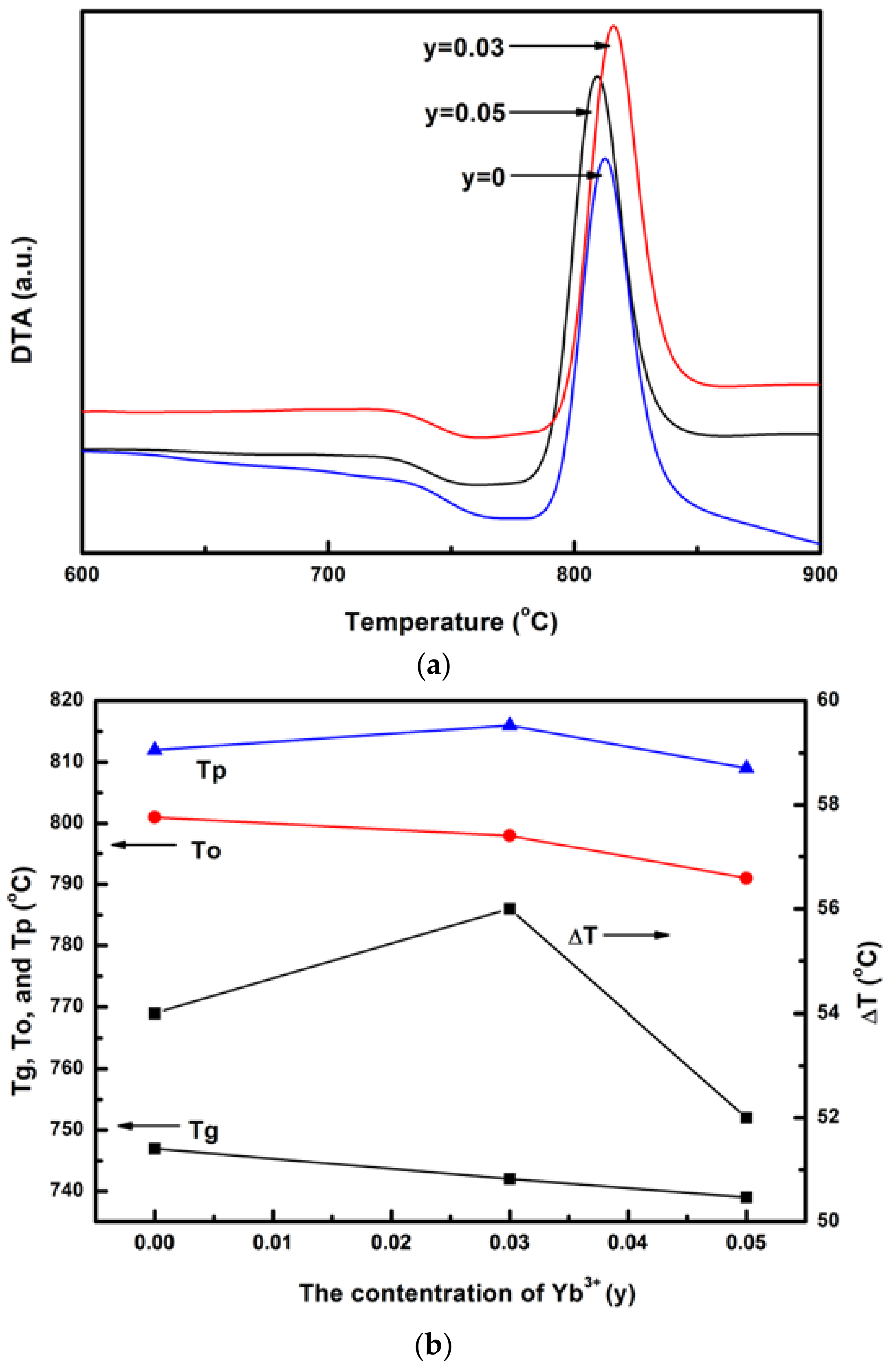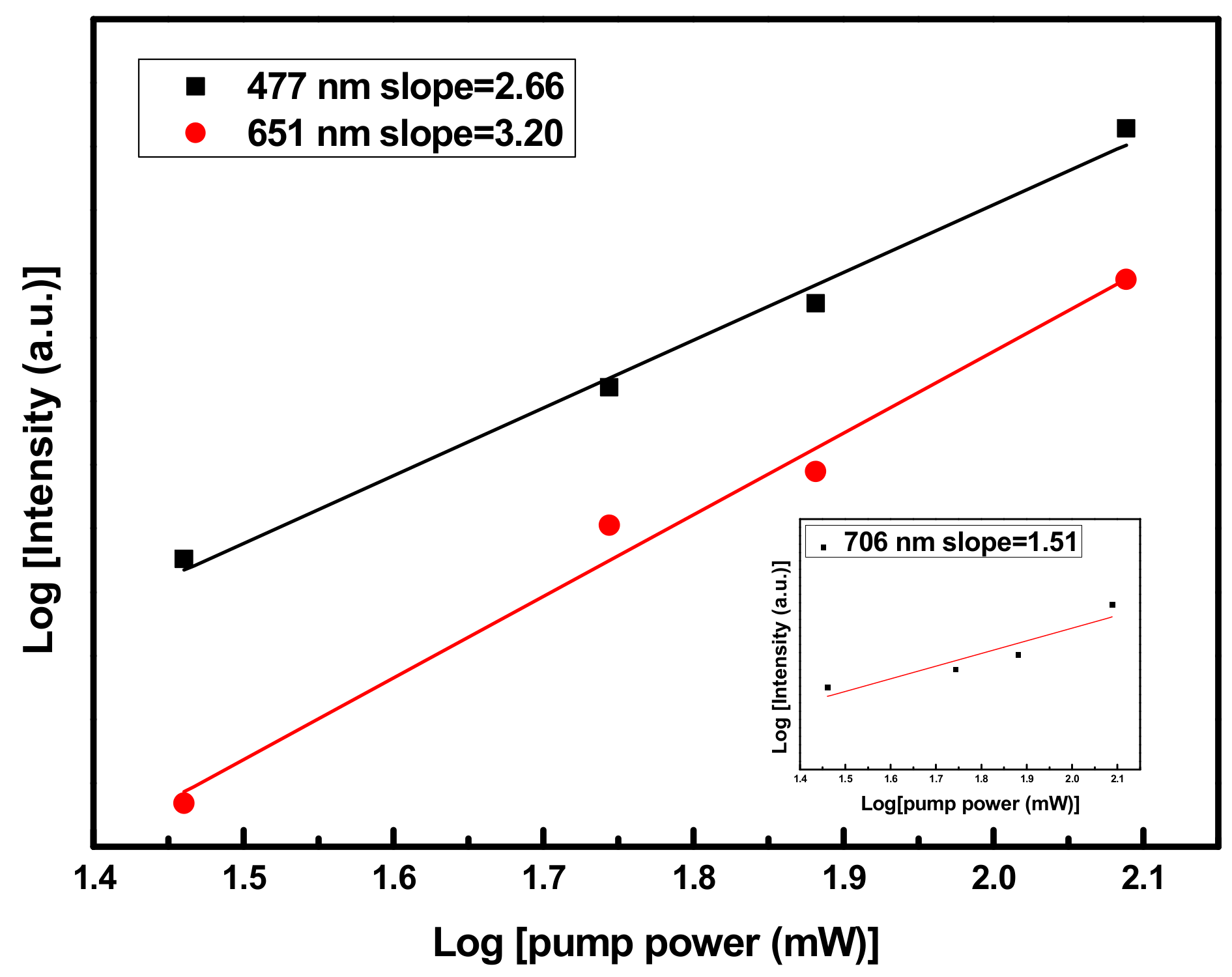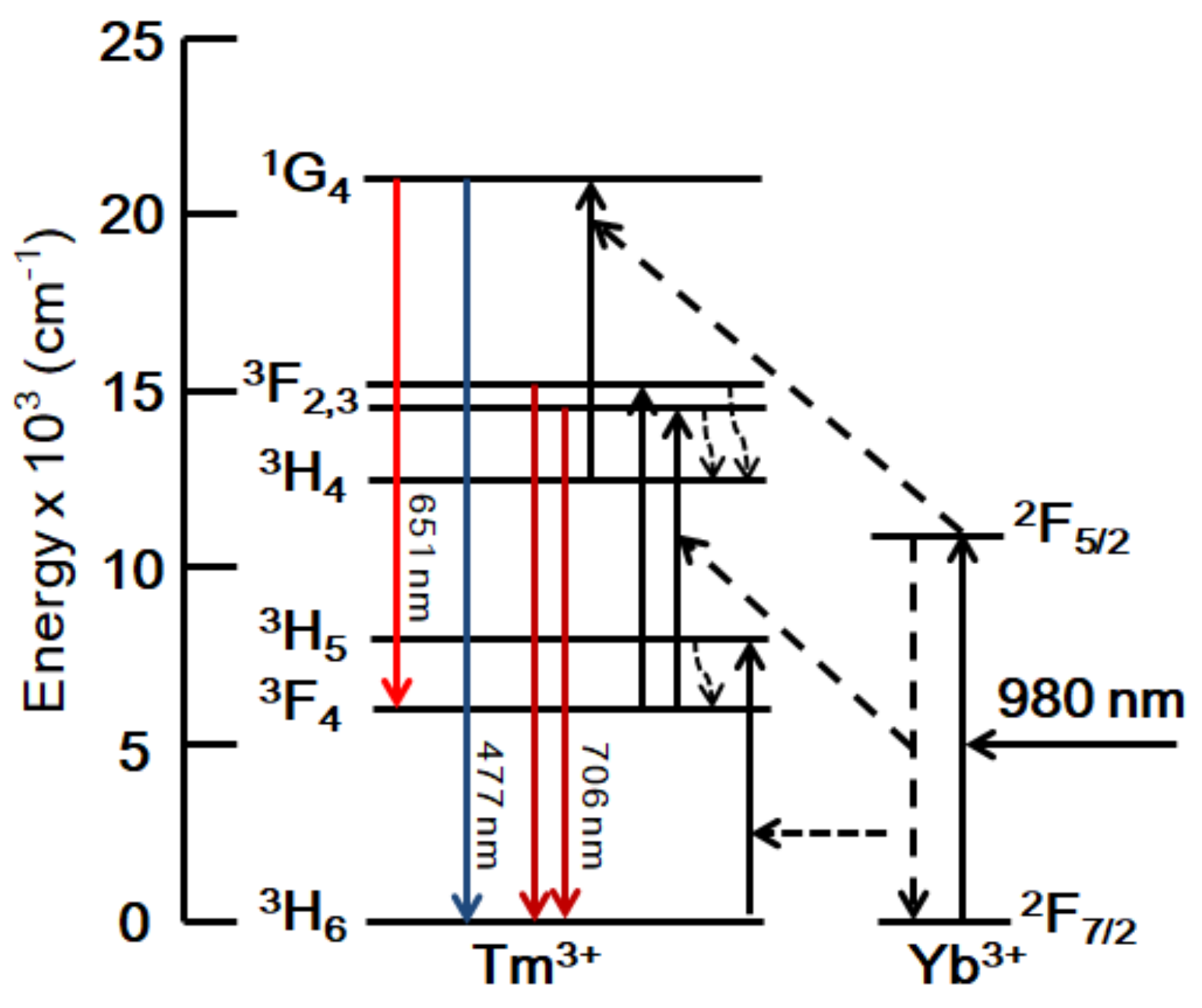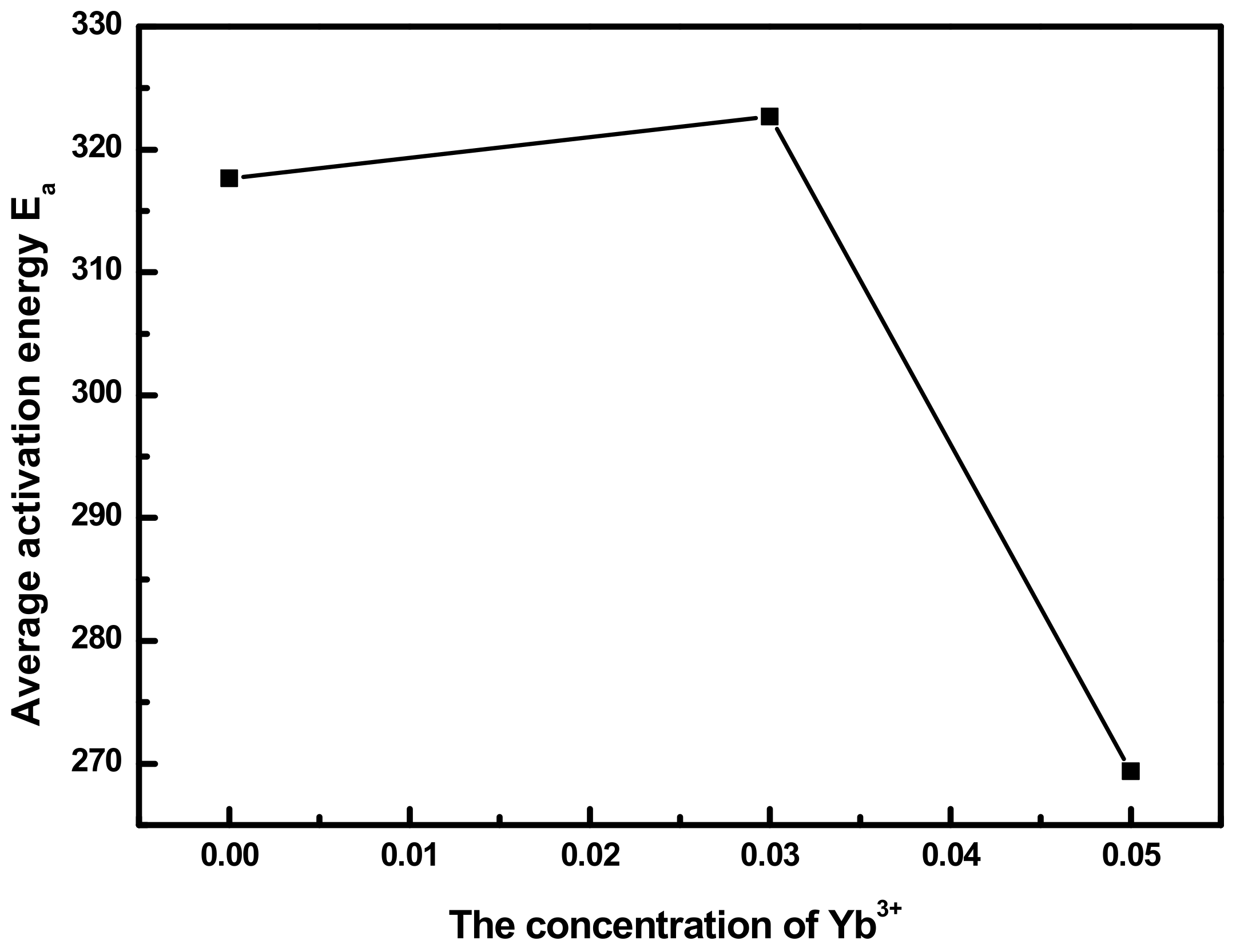Study on Upconversion and Thermal Properties of Tm3+/Yb3+ Co-Doped La2O3-Nb2O5-Ta2O5 Glasses
Abstract
:1. Introduction
2. Experimental
3. Results and Discussion
4. Conclusions
Author Contributions
Acknowledgments
Conflicts of Interest
References
- Yuan, M.H.; Fan, H.H.; Dai, Q.F.; Lan, S.; Wan, X.; Tie, S.L. Upconversion luminescence from aluminoborate glasses doped with Tb3+, Eu3+ and Dy3+ under the excitation of 2.6-μm femtosecond laser pulses. Opt. Express 2015, 23, 21909–21918. [Google Scholar] [CrossRef] [PubMed]
- Tang, J.; Sun, M.; Huang, Y.; Gou, J.; Zhang, Y.; Li, G.; Li, Y.; Man, Y.; Yang, J. Study on optical properties and upconversion luminescence of Er3+/Yb3+ co-doped tellurite glass for highly sensitive temperature measuring. Opt. Mater. Express 2017, 7, 3238–3250. [Google Scholar] [CrossRef]
- Basavapoornima, C.; Linganna, K.; Kesavulu, C.R.; Ju, S.; Kim, B.H.; Han, W.T.; Jayasankar, C.K. Spectroscopic and pump power dependent upconversion studies of Er3+-doped lead phosphate glasses for photonic applications. J. Alloys Compd. 2017, 699, 959–968. [Google Scholar] [CrossRef]
- Yang, Y.; Chu, Y.; Chen, Z.; Ma, Y.; Liao, L.; Li, H.; Peng, J.G.; Dai, N.L.; Li, J.Y.; Yang, L.Y. Blue upconversion luminescence for Yb3+/Tm3+ co-doped borosilicate glasses. J. Lumin. 2018, 195, 247–251. [Google Scholar] [CrossRef]
- Uchida, M.; Hayakawa, T.; Suhara, T.; Duclere, J.R.; Thomas, P. Raman investigation and glass-compositional dependence on blue up-conversion photoluminescence for Tm3+/Yb3+ co-doped TeO2-TlO0.5-ZnO glasses. Opt. Mater. Express 2014, 4, 823–835. [Google Scholar] [CrossRef]
- Georgescu, S.; Voiculescu, A.M.; Matei, C.; Stefan, A.; Toma, O.; Birjega, R. Upconversion luminescence in langatate ceramics doped with Tm3+ and Yb3+. J. Lumin. 2014, 154, 74–79. [Google Scholar] [CrossRef]
- Hou, X.; Zhou, S.; Lin, H.; Teng, H.; Li, Y.; Li, W.; Jia, T. Violet and blue upconversion luminescence in Tm3+/Yb3+ codoped Y2O3 transparent ceramic. J. Appl. Phys. 2010, 107, 083101. [Google Scholar] [CrossRef]
- Zhang, M.; Wen, H.; Yu, J.; Ai, F.; Yu, H.; Pan, X.; Shao, H.; Tang, M.B.; Gai, L. Investigation of upconversion luminescence in Er3+/Yb3+ co-doped Nb2O5-based glasses prepared by aerodynamic levitation method. Opt. Mater. Express 2017, 7, 3222–3230. [Google Scholar] [CrossRef]
- Mao, Z.; Duan, J.; Zheng, X.; Zhang, M.; Zhang, L.; Zhao, H.; Yu, J. Study on optical properties of La2O3-TiO2-Nb2O5 glasses prepared by containerless processing. Ceram. Int. 2015, 41, S51–S56. [Google Scholar] [CrossRef]
- Masuno, A.; Kohara, S.; Hannon, A.C.; Bychkov, E.; Inoue, H. Drastic connectivity change in high refractive index lanthanum niobate glasses. Chem. Mater. 2013, 25, 3056–3061. [Google Scholar] [CrossRef]
- Zhang, M.; Liu, Y.; Yu, J.; Pan, X.; Yoda, S. A novel upconversion TiO2-La2O3-Ta2O5 bulk glass co-doped with Er3+/Yb3+ fabricated by containerless processing. Mater. Lett. 2012, 66, 367–369. [Google Scholar] [CrossRef]
- Yu, J.; Arai, Y.; Masaki, T.; Ishikawa, T.; Yoda, S.; Kohara, S.; Taniguchi, H.; Itoh, M.; Kuroiwa, Y. Fabrication of BaTi2O5 glass-ceramics with unusual dielectric properties during crystallization. Chem. Mater. 2006, 18, 2169–2173. [Google Scholar] [CrossRef]
- Yoshimoto, K.; Masuno, A.; Inoue, H.; Watanabe, Y. Transparent and high refractive index La2O3-WO3 glass prepared using containerless processing. J. Am. Ceram. Soc. 2012, 95, 3501–3504. [Google Scholar] [CrossRef]
- Wu, C.; Zhang, M.; Zhai, D.; Yu, J.; Liu, Y.; Zhu, H.; Chang, J. Containerless processing for preparation of akermanite bioceramic spheres with homogeneous structure, tailored bioactivity and degradation. J. Mater. Chem. B 2013, 1, 1019–1026. [Google Scholar] [CrossRef]
- Pan, X.; Yu, J.; Liu, Y.; Yoda, S.; Zhang, M.; Ai, F.; Jin, F.; Yu, H.M.; Jin, W. Infrared to visible upconversion luminescence in Er3+/Yb3+ doped titanate glass prepared by containerless processing. J. Lumin. 2012, 132, 1025–1029. [Google Scholar] [CrossRef]
- Aasland, S.; Grande, T. Crystallization of ZBLAN glass. J. Am. Ceram. Soc. 1996, 79, 2205–2206. [Google Scholar] [CrossRef]
- Rosenflanz, A.; Frey, M.; Endres, B.; Anderson, T.; Richards, E.; Schardt, C. Bulk glasses and ultrahard nanoceramics based on alumina and rare-earth oxides. Nature 2004, 430, 761–764. [Google Scholar] [CrossRef] [PubMed]
- Pollnau, M.; Gamelin, D.R.; Lüthi, S.R.; Güdel, H.U.; Hehlen, M.P. Power dependence of upconversion luminescence in lanthanide and transition-metal-ion systems. Phys. Rev. B 2000, 61, 3337–3346. [Google Scholar] [CrossRef]
- Zhang, M.; Yu, J.; Pan, X.; Cheng, Y.; Liu, Y. Increase of the blue upconversion emission in Tm3+/Yb3+ co-doped titanate glass-ceramics. J. Non-Cryst. Solids 2013, 378, 106–109. [Google Scholar] [CrossRef]
- Zhang, M.H.; Yu, J.D.; Pan, X.H.; Cheng, Y.X.; Liu, Y. Preparation and upconversion luminescence of Nd3+/Yb3+ co-doped La2O3-TiO2-ZrO2 glass-ceramics. J. Inorg. Mater. 2013, 28, 896–900. [Google Scholar] [CrossRef]
- Abdel-Hameed, S.A.M.; El-Kheshen, A.A. Thermal and chemical properties of diopside-wollastonite glass-ceramics in the SiO2-CaO-MgO system from raw materials. Ceram. Int. 2003, 29, 265–269. [Google Scholar] [CrossRef]





© 2018 by the authors. Licensee MDPI, Basel, Switzerland. This article is an open access article distributed under the terms and conditions of the Creative Commons Attribution (CC BY) license (http://creativecommons.org/licenses/by/4.0/).
Share and Cite
Zhang, M.; Wen, H.; Pan, X.; Yu, J.; Shao, H.; Ai, F.; Yu, H.; Tang, M.; Gai, L. Study on Upconversion and Thermal Properties of Tm3+/Yb3+ Co-Doped La2O3-Nb2O5-Ta2O5 Glasses. Materials 2018, 11, 1352. https://doi.org/10.3390/ma11081352
Zhang M, Wen H, Pan X, Yu J, Shao H, Ai F, Yu H, Tang M, Gai L. Study on Upconversion and Thermal Properties of Tm3+/Yb3+ Co-Doped La2O3-Nb2O5-Ta2O5 Glasses. Materials. 2018; 11(8):1352. https://doi.org/10.3390/ma11081352
Chicago/Turabian StyleZhang, Minghui, Haiqin Wen, Xiuhong Pan, Jianding Yu, Hui Shao, Fei Ai, Huimei Yu, Meibo Tang, and Lijun Gai. 2018. "Study on Upconversion and Thermal Properties of Tm3+/Yb3+ Co-Doped La2O3-Nb2O5-Ta2O5 Glasses" Materials 11, no. 8: 1352. https://doi.org/10.3390/ma11081352



